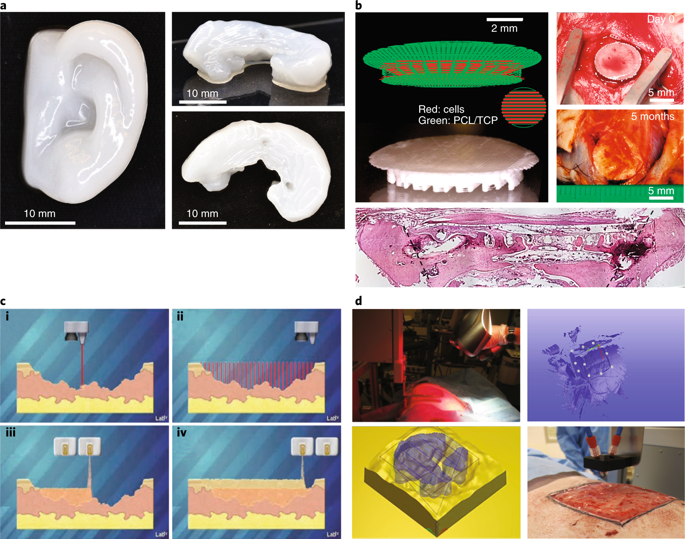当前位置:
X-MOL 学术
›
Nat. Biomed. Eng.
›
论文详情
Our official English website, www.x-mol.net, welcomes your feedback! (Note: you will need to create a separate account there.)
Opportunities and challenges of translational 3D bioprinting.
Nature Biomedical Engineering ( IF 28.1 ) Pub Date : 2019-11-06 , DOI: 10.1038/s41551-019-0471-7 Sean V Murphy 1 , Paolo De Coppi 2 , Anthony Atala 1
Nature Biomedical Engineering ( IF 28.1 ) Pub Date : 2019-11-06 , DOI: 10.1038/s41551-019-0471-7 Sean V Murphy 1 , Paolo De Coppi 2 , Anthony Atala 1
Affiliation

|
3D-printed orthopaedic devices and surgical tools, printed maxillofacial implants and other printed acellular devices have been used in patients. By contrast, bioprinted living cellular constructs face considerable translational challenges. In this Perspective, we first summarize the most recent developments in 3D bioprinting for clinical applications, with a focus on how 3D-printed cartilage, bone and skin can be designed for individual patients and fabricated using the patient's own cells. We then discuss key translational considerations, such as the need to ensure close integration of the living device with the patient's vascular network, the development of biocompatible bioinks and the challenges in deriving a physiologically relevant number of cells. Lastly, we outline untested regulatory pathways, as well as logistical challenges in material sourcing, manufacturing, standardization and transportation.
中文翻译:

转换式3D生物打印的机遇与挑战。
患者已使用3D打印的骨科设备和外科手术工具,打印的颌面植入物和其他打印的脱细胞设备。相比之下,生物打印的活细胞构建体面临相当大的翻译挑战。在此观点中,我们首先总结了3D生物打印在临床应用中的最新进展,重点是如何为个别患者设计3D打印的软骨,骨骼和皮肤,以及如何使用患者自己的细胞进行制造。然后,我们讨论了关键的翻译注意事项,例如确保将生活设备与患者血管网络紧密集成的需要,生物相容性生物墨水的开发以及在获得生理上相关的细胞数量方面的挑战。最后,我们概述了未经测试的监管途径,
更新日期:2019-11-06
中文翻译:

转换式3D生物打印的机遇与挑战。
患者已使用3D打印的骨科设备和外科手术工具,打印的颌面植入物和其他打印的脱细胞设备。相比之下,生物打印的活细胞构建体面临相当大的翻译挑战。在此观点中,我们首先总结了3D生物打印在临床应用中的最新进展,重点是如何为个别患者设计3D打印的软骨,骨骼和皮肤,以及如何使用患者自己的细胞进行制造。然后,我们讨论了关键的翻译注意事项,例如确保将生活设备与患者血管网络紧密集成的需要,生物相容性生物墨水的开发以及在获得生理上相关的细胞数量方面的挑战。最后,我们概述了未经测试的监管途径,


























 京公网安备 11010802027423号
京公网安备 11010802027423号